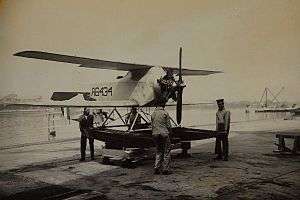Caspar U.1
| Caspar U.1 | |
|---|---|
 | |
| U.1 under test by the US Navy | |
| Role | Submarine-launched patrol seaplane |
| National origin | Germany |
| Manufacturer | Caspar-Werke |
| Designer | Ernst Heinkel |
| First flight | 1922 |
| Primary user | Reichsmarine |
| Number built | 3 |
|
| |
The Caspar U.1 (sometimes known as the Caspar-Heinkel U.1) was a 1920s German patrol seaplane designed by Ernst Heinkel and built by Caspar-Werke.[1] The U.1 was designed to fit into a cylindrical container to allow it to be carried, then launched from a submarine.[1]
Development
The U.1 was designed to meet a requirement to fit inside a cylindrical container 7.40 metres (24.3 ft) long with a diameter of 1.70 m (5 ft 7 in); this allowed the aircraft to be carried by a submarine.[1] To reduce the time to launch the aircraft, it was built as a cantilever biplane to remove the need to rig struts and wires on assembly.[1] The U.1 had two single-step floats and was powered by a front-mounted 55-horsepower (41 kW) Siemens radial piston engine.[1] The pilot had an open cockpit behind the upper wing which gave a clear view forward.[1] It is claimed that during tests, four men could remove the U.1 from the container and erect it in 1 minute 3 seconds.[1] Two aircraft were bought by the United States Navy for evaluation;[1] these were delivered to Naval Air Station Anacostia in late 1922, and were tested during 1923; one of the aircraft was damaged beyond repair whilst mounted on a truck for a parade.[2]
Operators
Specifications
Data from [3]
General characteristics
- Crew: 1
- Length: 6.20 m (20 ft 4 in)
- Wingspan: 7.20 m (23 ft 7 in)
- Height: 2.59 m (8 ft 6 in)
- Wing area: 14.00 m2 (150.7 sq ft)
- Empty weight: 360 kg (794 lb)
- Gross weight: 572 kg (1,261 lb)
- Fuel capacity: Fuel and oil 44 kg (97 lb)
- Powerplant: 1 × Siemens-Halske Sh 4 radial piston engine, 41 kW (55 hp)
Performance
- Maximum speed: 145 km/h (90 mph; 78 kn) at sea level
- Cruising speed: 120 km/h (75 mph; 65 kn) at saea level
- Range: 360 km (224 mi; 194 nmi)
- Service ceiling: 3,000 m (9,843 ft)
- Time to altitude: 1,000 m (3,300 ft) in 6 min; 2,000 m (6,600 ft) in 15 min 34 sec; 3,000 m (9,800 ft) in 34 min 52 sec
See also
- Related lists
References
| Wikimedia Commons has media related to Caspar-Werke. |
- Notes
- 1 2 3 4 5 6 7 8 Orbis 1985, p. 1060
- ↑ Treadwell, Terry (February 1983). "Submarine Aviation". Naval Aviation News. Washington, DC: Naval Air Systems Command. 65 (2): 9. ISSN 0028-1417.
- ↑ "Caspar U 1". http://www.histaviation.com/Caspar_U_1.html. Retrieved 13 April 2015. External link in
|website=(help)
- Bibliography
- The Illustrated Encyclopedia of Aircraft (Part Work 1982-1985). Orbis Publishing.